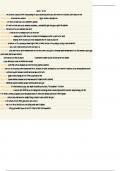SUMMARY CMR EXAM
Lecture 1-7
Incl. practice questions + answers
I took the course last year and even though the lectures are in different
order and sometimes combined, the content is the same what you need
to study for the exam (I checked this year’s slides don’t worry ;) )
GOOD LUCK <3
,2
, 3
Lecture 1 | Introduction
Marketing research is the systematic and objective identification, collection,
dissemination and analysis of information for improving decision-making related to
identifying and solving problems and opportunities in marketing.
- Start with a question and find relevant information to answer that
problem.
● DATA (unfiltered, raw) 10 consumers bought a product when priced 5$, 13
consumers bought it when priced 8$ → INFORMATION (relations) more
consumers bought the brand when it was more expensive → KNOWLEDGE
(patterns) consumers respond positively to price→ WISDOM (fundamental
principles) consumers aren't utility maximise
1. Problem Definition:
- Decision Problem: What we talk about most of the time. Focuses on
the action. “How should we position our product on supermarket
shelves to attract maximum consumer attention?”
- Research Problem: Focuses on understanding. A step before we take
action. Before we take action, we must understand how consumers will
react. “How does shelf positioning affect consumer attention?”
2. Research approach:
- An exploratory research goal may be rule-based or data-driven.
- With an explanatory research goal, a conceptual model should be
guided by theory. In simple terms, a research model determines the
relationship between different variables (When you have a prediction).
● Research Model: Focus on three fundamental types of relationships/variables
○ Main Effect: Does the IV influence
the DV?
■ The hypothesis must include
(a) all variables and (b) the
direction of the relationship
■ Portion size influences the
consumption amount
(NO DIRECTION = NOT
MEASURABLE!)
■ Portion size positively influences the consumption amount
■ Consumption amount will be more significant with a large portion
compared to a small portion
, 4
○ Moderation: When Main Effects change
■ Whenever we study a relationship between two variables, that
relationship can change based on different circumstances.
■ The direction or strength of the effect of IV on DV is affected by
a moderating variable (or Moderator)
■ Example Question: How can Sarah test whether the effect of
relationship status on holiday enjoyment differs between men
and women? (Moderator: Relationship status)
■ Food healthiness moderates the influence of portion size on
consumption amount (no direction = not measurable)
■ The positive effect of portion size on consumption amount is
greater for unhealthy foods than for healthy foods.
○ Mediation: Not when but WHY
■ “Investigates why, when you are given a bigger portion size, you
eat more” Mediating variable explains WHY
■ Whereas moderator variables specify when specific effects will
hold, mediators speak about how or why such effects occur
■ Value for money mediates the effect of portion size on
consumption amount (X)
■ Value for money mediates the positive effect of portion size on
consumption amount: a larger (vs smaller) portion provides
higher value for money, which will, in turn, increase the
consumption amount
3. Research Design: framework for
conducting the research product
- Determines the information that's
needed to answer specific
research questions or test the
developed conceptual model and
hypothesis
- Takes into account:
■ Nature of the issue: common behaviour (spontaneous
response), personal or sensitive issues, repressed tendencies
■ Nature of respondents: age, background, previous participation
■ Context: cultural norms, ease of data collection
- Experiments are the best way to test causal impact.
■ “Does the green packaging compared to the blue packaging
cause people to buy more?”
■ AB testing for advertising
■ Example Experiment:











